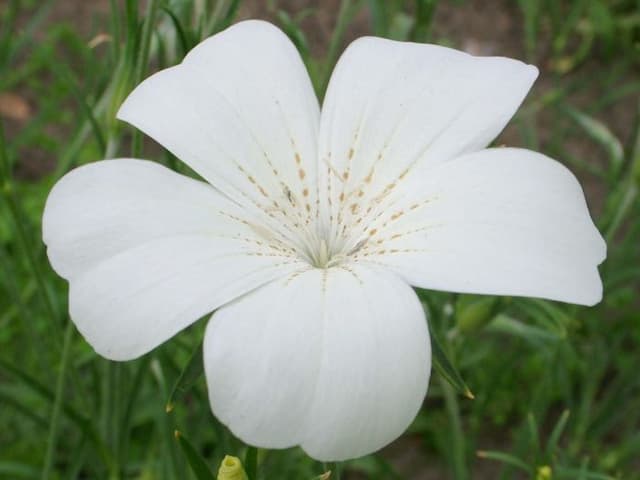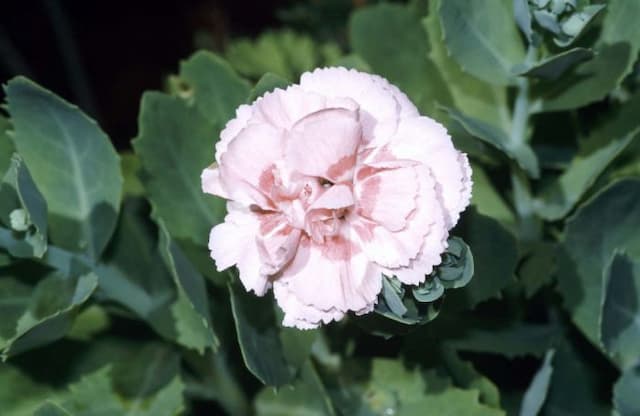Garden Pink Dianthus Fizzy = 'Wp08 Ver03' (PBR) (Early Bird Series) (p)
![pink [Fizzy]](/_next/image?url=https%3A%2F%2Fplants-admin.emdemapps.com%2Fimages%2Fplants%2F%2Fimages%2F604b5fa899f50.png&w=3840&q=75)
ABOUT
The Dianthus Fizzy, which is part of the Early Bird Series, presents a cheerful display of blooms. The flowers are particularly notable for their frilly edges, giving them a textured and fluffy appearance. Often, they come in a mix of bright pink hues, sometimes featuring unique patterns like picotee edges where the main color fades to a lighter tone or a different shade along the margins. These blossoms typically have a sweet and spicy fragrance, which makes them quite appealing not only visually but also for their pleasant scent. The foliage of the plant is slender and blue-green in color, forming a neat, mounded cushion beneath the flowers. This provides a nice contrast to the vibrant colors of the blossoms above. Overall, the Dianthus Fizzy exudes a cottage-garden charm and adds a burst of color to any setting where it is planted, making it a beloved choice for gardeners looking to infuse their outdoor spaces with life and fragrance.
About this plant
 Names
NamesFamily
Caryophyllaceae
Synonyms
Fizzy Pink, Early Bird Fizzy
Common names
Dianthus 'Wp08 Ver03'
 Toxicity
ToxicityTo humans
The Dianthus 'Early Bird Fizzy', commonly known as Carnation, is not considered toxic to humans. In general, Dianthus species are not known for being poisonous. If ingested, they usually do not cause any harmful effects. However, people with sensitive skin may sometimes experience dermatitis from handling the plants due to skin irritation from plant sap.
To pets
Carnations are generally considered mildly toxic to pets, such as cats and dogs. If a pet ingests a significant quantity of a carnation, it might experience mild gastrointestinal symptoms, including vomiting or diarrhea. It's always best to keep an eye on your pet and consult a veterinarian if any unusual behavior or symptoms occur after they ingest any part of a plant.
 Characteristics
CharacteristicsLife cycle
Perennials
Foliage type
Evergreen
Color of leaves
Green
Flower color
Mixed
Height
1 foot (30 cm)
Spread
1 foot (30 cm)
Plant type
Herb
Hardiness zones
7
Native area
Europe
Benefits
 General Benefits
General Benefits- Easy to grow - The plant is known for being low-maintenance and adaptable to various growing conditions.
- Long flowering period - Dianthus offers a prolonged blooming season, providing colorful flowers for an extended time.
- Aesthetic appeal - With its vibrant and diverse colors, Dianthus enhances visual interest in gardens or landscapes.
- Attracts pollinators - It attracts beneficial insects like bees and butterflies, promoting pollination in the garden.
- Tolerant to cold - Dianthus is hardy in cool temperatures, making it suitable for a range of climates.
- Drought-resistant - Once established, the plant can tolerate periods of dry weather, reducing the need for frequent watering.
- Compact growth - The plant's compact and neat growth habit makes it ideal for borders, containers, and small garden spaces.
- Deer resistant - Dianthus is generally not preferred by deer, making it easier to maintain in areas with wildlife.
 Medical Properties
Medical PropertiesThis plant is not used for medical purposes.
 Air-purifying Qualities
Air-purifying QualitiesThis plant is not specifically known for air purifying qualities.
 Other Uses
Other Uses- Culinary Garnish: The vibrant petals of Dianthus can be used to add color and a light spicy flavor to salads and desserts.
- Artistic Dye: The colorful blooms can be used to create natural dyes for fabrics or paper, offering a range of pink and red hues.
- Floral Crafts: Dried Dianthus flowers can be incorporated into potpourri mixes or used to create decorative wreaths and arrangements.
- Bookmarks: Pressed Dianthus flowers can be laminated to create unique and ornamental bookmarks.
- Perfumery: The sweet fragrance of Dianthus flowers can be captured in homemade perfumes or scented sachets for drawers and closets.
- Photography: As an appealing subject, Dianthus can be used in macro photography to showcase the intricate details of its petals.
- Event Decor: Fresh Dianthus flowers can serve as natural confetti or table scatter for weddings and celebrations.
- Greeting Cards: The flowers or their images can be used to enhance the design of handmade greeting cards or invitations.
- Education: Dianthus plants can be used in botanical studies and gardening workshops to teach about plant growth and care.
- Seasonal Display: Dianthus can be planted with other seasonal blooms to create themed garden displays for various holidays and occasions.
Interesting Facts
 Feng Shui
Feng ShuiThe Carnation is not used in Feng Shui practice.
 Zodiac Sign Compitability
Zodiac Sign CompitabilityThe Carnation is not used in astrology practice.
 Plant Symbolism
Plant Symbolism- Admiration: Dianthus flowers, commonly known as Pinks, typically symbolize admiration due to their attractive patterns and delightful fragrance.
- Passion: The bright and rich hues of Pinks often represent passionate feelings, making them an appropriate gift for expressing love or strong emotions.
- Pure Affection: In some cultures, giving someone Pinks is a way to show pure or platonic affection, as the flowers are believed to carry a sweet and sincere energy.
- Dignity and Nobility: Historically, Pinks were associated with nobility and elegance, and thus they can denote dignity or a regal aura.
- Boldness: The vivid colors and enduring nature of Dianthus signify boldness and a challenge to confront the trials of life with strength.
 Water
WaterSweet William, also known as Dianthus Fizzy, should be watered regularly to maintain moist but not waterlogged soil. It's essential to allow the top inch of soil to dry out between waterings to prevent root rot. Typically, watering once a week with approximately 16 to 32 ounces of water is adequate. During hot, dry periods, the frequency may need to increase, and during cooler, wetter months, it may decrease. Always check the soil moisture level before watering to ensure the plant receives the right amount.
 Light
LightSweet William thrives in full sun to partial shade. The best spot for this plant is an area that receives at least 6 to 8 hours of direct sunlight daily, though it can tolerate some afternoon shade, especially in hotter climates. Avoid placing it in deep shade as this can lead to poor flowering and leggy growth.
 Temperature
TemperatureSweet William prefers a temperature range that's generally between 40°F and 85°F, which covers a range of typical outdoor conditions. The plant can survive minimum temperatures as low as 30°F; however, it will not tolerate frost well. Ideal growing conditions are in cooler temperatures that stay around the lower part of the range during the growing season.
 Pruning
PruningSweet William should be pruned to encourage bushiness, induce more flowering and remove dead or faded flowers, which is known as deadheading. Prune or deadhead after the first flush of blooms to promote a second bloom period. Late winter or early spring is the best time to cut back the foliage to encourage healthy new growth. Generally, pruning can be done every few weeks during the blooming season to keep the plant tidy and maintain its shape.
 Cleaning
CleaningAs needed
 Soil
SoilCarnations require well-draining soil with a mix of one part garden soil, one part coarse sand or perlite, and one part peat or compost to ensure good drainage and aeration. The soil pH should be slightly alkaline, around 6.75 to 7.5.
 Repotting
RepottingCarnations typically don't need frequent repotting and can thrive up to 2-3 years before requiring a larger pot. It is best to repot in spring before the onset of active growth.
 Humidity & Misting
Humidity & MistingCarnations prefer moderate humidity levels, around 40-60%. They can tolerate some dry air but should not be subjected to very high humidity environments for extended periods.
 Suitable locations
Suitable locationsIndoor
Place in bright light, avoid high humidity, and ensure good air circulation.
Outdoor
Full sun, fertile well-drained soil, protect from extreme wet.
Hardiness zone
3-9 USDA
 Life cycle
Life cycleThe Dianthus Fizzy, commonly known as Sweet William, begins its life cycle as a seed, which, when sown in well-drained soil and provided with ample sunlight, will germinate and sprout. Seedlings then grow into a rosette of foliage at the base, a phase which is critical for establishing a strong root system. With proper care, the plant progresses to a vegetative stage, producing stems and leaves in preparation for the next phase of development. As it enters the flowering stage, the Dianthus Fizzy produces clusters of vibrant, fringed flowers that are often highly fragrant, attracting pollinators such as bees and butterflies. After pollination, the plant will produce seeds, completing its reproductive cycle. The Dianthus Fizzy is a perennial, meaning it can go through this life cycle for several years if it is not subjected to overly harsh winters or other conditions that could cause it to behave as an annual or biennial.
 Propogation
PropogationPropogation time
Spring to Summer
Dianthus Fizzy = 'Wp08 Ver03' (PBR) (Early Bird Series) (p), commonly known as Dianthus, is most commonly propagated through cuttings. This method is popular because it reliably produces clones of the parent plant, ensuring consistency in the progeny's characteristics. To propagate Dianthus from cuttings, one would take a 3 to 5-inch (about 7.6 to 12.7 centimeters) long stem cutting from a healthy parent plant, ideally during late spring or early summer when the plant's growth is most vigorous. The lower leaves are removed, and the cut end is often dipped in rooting hormone to increase the chances of successful rooting. The cutting is then planted in a well-draining soil mix, ensuring that some of the leaf nodes where new roots can emerge are below the surface. The soil should be kept moist but not waterlogged, and the cutting should be placed in a well-lit area without direct sunlight until roots have developed, which typically takes a few weeks. Once rooted, the new plant can be gradually acclimatized to normal growing conditions and eventually transplanted to its final location.








![Pink [Bubblegum]](/_next/image?url=https%3A%2F%2Fplants-admin.emdemapps.com%2Fimages%2Fplants%2F%2Fimages%2F604b596f31cbb.png&w=640&q=75)
